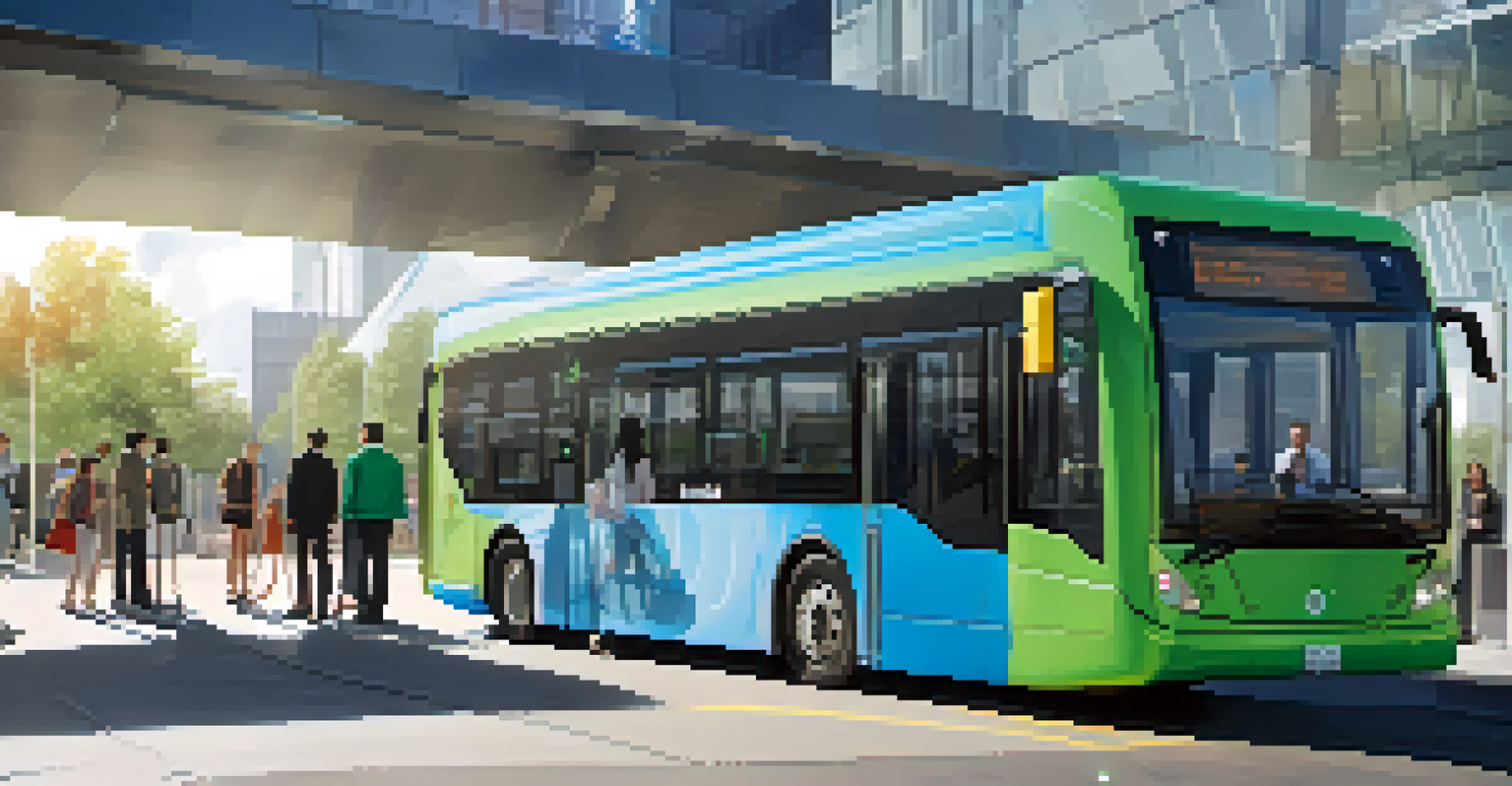Sustainable Transportation Solutions to Reduce Urban Pollution

The Growing Need for Sustainable Transportation
Urban areas are facing a significant pollution crisis that affects both health and the environment. As cities expand, the increase in vehicle emissions contributes to poor air quality, leading to respiratory issues and other health problems. Sustainable transportation solutions are essential to mitigate these effects and promote cleaner air for all residents.
The best way to predict the future is to create it.
With more people moving to cities, the challenge of reducing pollution becomes even more pressing. Traditional modes of transport, such as cars and buses, are often not the most efficient or eco-friendly. By adopting sustainable practices, cities can not only improve air quality but also enhance the overall quality of life for their inhabitants.
Moreover, investing in sustainable transportation can lead to long-term economic benefits. Reduced pollution can lower healthcare costs associated with respiratory diseases, while also attracting businesses that prioritize sustainability. It's a win-win for both the environment and the economy.
Public Transportation: A Key Player in Urban Mobility
Public transportation systems, such as buses, trams, and subways, play a crucial role in reducing urban pollution. By providing an efficient alternative to individual car use, public transit can significantly lower the number of vehicles on the road. This not only reduces emissions but also helps to alleviate traffic congestion, making cities more navigable.

Investing in modern, electrified public transport options can amplify these benefits. For example, electric buses produce zero emissions at the tailpipe, making them an excellent choice for urban environments. Additionally, cities that prioritize public transit infrastructure often see a rise in ridership, further decreasing pollution levels.
Sustainable Transport Improves Air Quality
Adopting sustainable transportation solutions can significantly reduce urban pollution and enhance residents' health.
Encouraging public transportation use can also foster a sense of community. When more people rely on shared transit, they interact more, leading to vibrant neighborhoods. This social aspect of public transport can enhance the overall urban experience, making cities more enjoyable places to live.
Biking and Walking: The Power of Active Transportation
Biking and walking are two of the most sustainable forms of transportation available. They require no fuel and produce no emissions, making them ideal for reducing urban pollution. Cities that invest in bike lanes and pedestrian pathways often see a substantial increase in active transportation use, leading to healthier populations and cleaner air.
Sustainability is no longer about doing less harm. It's about doing more good.
Moreover, promoting biking and walking helps to create a more connected community. When people can easily navigate their neighborhoods on foot or by bike, they are more likely to engage with local businesses and participate in community events. This fosters a sense of belonging and can significantly boost local economies.
Incorporating bike-sharing programs and pedestrian-friendly initiatives can further encourage these modes of transport. By providing accessible options for all residents, cities can create a culture that prioritizes sustainability. As more people choose biking and walking, urban pollution levels can decrease, leading to a healthier environment.
Electric Vehicles: A Cleaner Future on the Roads
Electric vehicles (EVs) are becoming increasingly popular as a sustainable transportation option. With zero tailpipe emissions, EVs can significantly reduce urban pollution, especially in densely populated areas. As battery technology improves and charging infrastructure expands, more people are making the switch to electric.
Incentives such as tax credits and rebates can further encourage the adoption of electric vehicles. Cities can also invest in charging stations to support EV owners, making it more convenient for everyone. As the number of electric vehicles on the road increases, urban air quality stands to improve dramatically.
Public Transit Reduces Traffic Congestion
Efficient public transportation systems alleviate traffic and emissions, fostering a more navigable urban environment.
Furthermore, integrating EVs into public transportation systems can amplify their positive impact. Electric buses and taxis can provide cleaner alternatives to traditional fossil-fuel-powered vehicles, helping cities achieve their sustainability goals. This shift to electric mobility is a crucial step toward combating urban pollution.
Carpooling and Ridesharing: Sharing for a Greener City
Carpooling and ridesharing services are effective strategies for reducing the number of vehicles on the road. By sharing rides, individuals can lower their carbon footprint and contribute to a decrease in urban pollution. These practices not only save on fuel costs but also create a sense of camaraderie among commuters.
Many cities have developed platforms to facilitate carpooling, making it easier for residents to connect. Incentives like dedicated carpool lanes can further encourage participation, enhancing the efficiency of shared rides. As more people opt for these options, cities can experience less traffic congestion and improved air quality.
Moreover, ridesharing services, when combined with electric vehicles, can significantly reduce emissions. By providing accessible and eco-friendly transportation options, cities can encourage a shift away from single-occupancy vehicles. Ultimately, this collaborative approach can contribute to healthier urban environments.
Innovative Solutions: Technology’s Role in Sustainable Transport
Technology plays a pivotal role in shaping sustainable transportation solutions. Innovations such as smart traffic management systems can optimize traffic flow, reducing congestion and emissions. By using real-time data, cities can make informed decisions to improve their transportation infrastructure.
Apps that promote public transit, biking, and ridesharing can also encourage sustainable choices. By providing users with information about the most eco-friendly routes and options, these tools empower individuals to make greener decisions. As technology continues to evolve, its potential to enhance urban mobility grows exponentially.
Community Engagement Drives Change
Active involvement in transportation planning empowers communities to implement effective sustainable practices.
Moreover, advancements in autonomous vehicles can revolutionize the way we think about transportation. By minimizing the need for personal cars, these technologies could reduce the overall number of vehicles on the road. This shift could lead to cleaner, more sustainable urban environments, paving the way for a brighter future.
Collaborative Efforts: Mobilizing Communities for Cleaner Cities
Community involvement is crucial for the success of sustainable transportation initiatives. When residents actively participate in discussions about transportation planning, they can help shape solutions that meet their unique needs. This collaborative approach fosters a sense of ownership and investment in local sustainability efforts.
Cities can host workshops and forums to educate residents about the benefits of sustainable transportation. By raising awareness and promoting community engagement, cities can inspire individuals to adopt eco-friendly practices. These grassroots efforts can lead to significant positive changes in urban pollution levels.

Additionally, partnerships with local businesses and organizations can enhance these initiatives. By working together, communities can create comprehensive transportation plans that prioritize sustainability. Ultimately, when everyone collaborates toward a common goal, cities can become cleaner and healthier places to live.